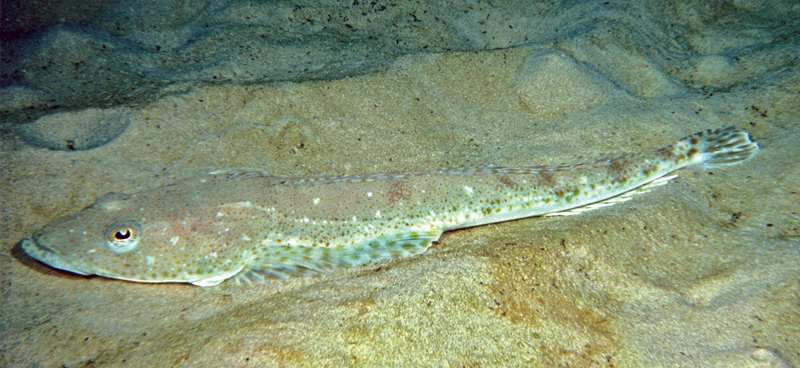- Classification
- ACTINOPTERYGII
- SCORPAENIFORMES
- PLATYCEPHALIDAE
- Platycephalus
- aurimaculatus
Toothy Flathead, Platycephalus aurimaculatus Knapp 1987

Toothy Flathead, Platycephalus aurimaculatus . Source: Rudie H. Kuiter / Aquatic Photographics. License: All rights reserved
A large flathead with low, mostly smooth ridges on the head, 2 strong spines at the angle of the gill cover, the lower slightly longer than the upper, and large canines on the tip of the upper jaw.
The Toothy Flathead is sandy greyish-brown above with many small yellow to orange spots and scattered larger white spots, and sometimes darker blotches posteriorly. The pectoral and pelvic fins have large yellowish blotches, and the caudal fin is pale with distinct bands to irregular yellowish spots.
Toothy Flathead, Platycephalus aurimaculatus Knapp 1987
More Info
|
Distribution |
Endemic to temperate waters of southern Australia, from southern New South Wales to about Israelite Bay (Western Australia) and around Tasmania. Inhabits sandy and silty areas in bays and coastal waters at depths of 10-160 m. |
|
Features |
Dorsal fin IX (rarely VIII), 14; Anal fin 14 (rarely 13 or 15); Caudal fin 15; Pectoral fin 16-20 (rarely 20); Pelvic fin I, 5; Lateral line scales (pored) 75-85. Body elongate, slightly depressed. Head large (length 29-33% SL), depressed, with several low, mostly spineless ridges; eyes large (19-23% HL) with long iris lappet; mouth large with greatly enlarged canines on tip of upper jaw and on palatines, somewhat smaller teeth in lower jaw and on vomer; two strong preopercular spines at angle of preopercle, lower slightly larger than upper; gill rakers on lower limb of first arch rudimentary, stumpy rather than long and slender. Scales small, finely ctenoid, covering body and most of head behind eyes; lateral line scales slightly larger than adjacent scales on side, ~88-94 oblique rows of scales above lateral line, anteriormost scale with small spine or ridge. First dorsal fin spinous with short base, first spine very short, detached, following spines much longer. Second dorsal fin with moderately long base, anterior rays longest, nearly as long as longest first dorsal spines. Anal fin similar in shape, opposite and slightly longer-based than second dorsal fin. Caudal fin truncate to slightly rounded. Pectoral fins moderately small. Pelvic fins long, based below centre of pectoral fins. Swim bladder absent. |
|
Size |
Maximum length at least 55 cm. |
|
Colour |
Sandy greyish brown dorsally with numerous small yellow or golden spots and some scattered larger white spots over head and body, sometimes darker blotches posteriorly. Caudal fin pale with distinct, irregular, moderate-sized yellowish spots or bands; pectoral and pelvic fins with large yellowish blotches. |
|
Feeding |
Feeds mostly on fishes, and also consumes large benthic crustaceans. |
|
Biology |
Little is known of the biology of this species. |
|
Fisheries |
Usually taken in trawls but is occasionally caught on hook and line. |
|
Species Citation |
Platycephalus (Neoplatycephalus) aurimaculatus Knapp 1987, Mem. Nat. Mus. Vict. 48(1): 53. Type locality:Bass Strait, east of King Island, 39°56.41'S, 144°48.054'E, Tasmania, Australia, depth 49 m. |
|
Author |
Australian National Fish Collection, CSIRO & Bray, D.J. 2017 |
|
Resources |
Toothy Flathead, Platycephalus aurimaculatus Knapp 1987
References
Gomon, M.F. 2008. Family Platycephalidae. pp. 515-521 in Gomon, M.F., Bray, D.J. & Kuiter, R.H. (eds). Fishes of Australia's Southern Coast. Sydney : Reed New Holland 928 pp.
Imamura, H. 1996. Phylogeny of the family Platycephalidae and related taxa (Pisces: Scorpaeniformes). Species Diversity 1(2): 123-233
Imamura, H. 2015. Taxonomic revision of the flathead fish genus Platycephalus Bloch, 1785 (Teleostei: Platycephalidae) from Australia, with description of a new species. Zootaxa 3904(2): 151–207
Keenan, C.P. 1991. Phylogeny of Australian species of flatheads (Teleostei, Platycephalidae) as determined by allozyme electrophoresis. Journal of Fish Biology 39(Supplement A): 237-249
Knapp, L.W. 1987. New Australian fishes. Part 13. Two new species of Platycephalidae. Memoirs of the National Museum of Victoria 48(1): 53-55 PDF available, open access
Knapp, L.W. 1991. Platycephalus chauliodous, a new flathead fish from the eastern Indian Ocean (Teleostei: Platycephalidae). Proceedings of the Biological Society of Washington 104(1): 23-29 (as Neoplatycephalus aurimaculatus)
Kuiter, R.H. 1993. Coastal Fishes of South-eastern Australia. Bathurst : Crawford House Press 437 pp. (as Neoplatycephalus aurimaculatus)
Kuiter, R.H. 1994. Family Platycephalidae. pp. 514-523 figs 458-465 in Gomon, M.F., Glover, C.J.M. & Kuiter, R.H. (eds). The Fishes of Australia's South Coast. Adelaide : State Printer 992 pp. 810 figs.
Last, P.R., Scott, E.O.G. & Talbot, F.H. 1983. Fishes of Tasmania. Hobart : Tasmanian Fisheries Development Authority 563 pp. figs. (as Platycephalus sp.)
May, J.L. & Maxwell, J.G.H. 1986. Field Guide to Trawl Fish from Temperate Waters of Australia. Hobart : CSIRO Division of Marine Research 492 pp. (as Neoplatycephalus sp. 1)
Yearsley, G.K., Last, P.R. & Ward, R.D. 2001. Australian Seafood Handbook: an identification guide to domestic species. FRDC / CSIRO Marine Research, 469 pp.

